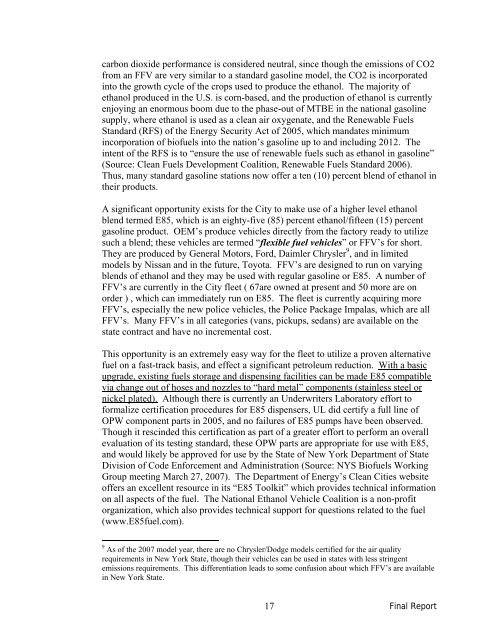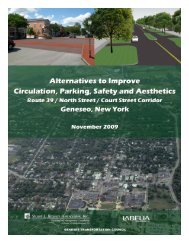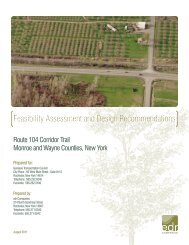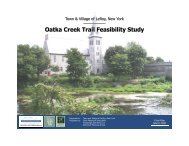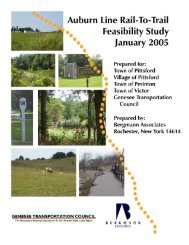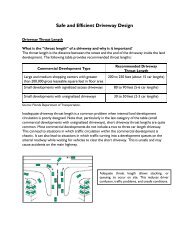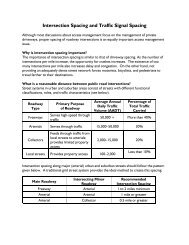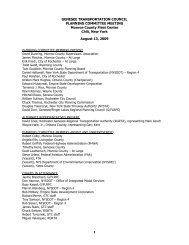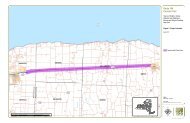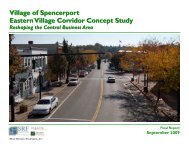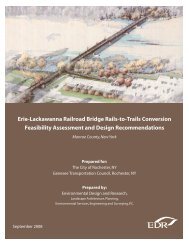Final Report Rochester Vehicle Fleet Alternative Fuels Systems Study
Final Report Rochester Vehicle Fleet Alternative Fuels Systems Study
Final Report Rochester Vehicle Fleet Alternative Fuels Systems Study
Create successful ePaper yourself
Turn your PDF publications into a flip-book with our unique Google optimized e-Paper software.
carbon dioxide performance is considered neutral, since though the emissions of CO2<br />
from an FFV are very similar to a standard gasoline model, the CO2 is incorporated<br />
into the growth cycle of the crops used to produce the ethanol. The majority of<br />
ethanol produced in the U.S. is corn-based, and the production of ethanol is currently<br />
enjoying an enormous boom due to the phase-out of MTBE in the national gasoline<br />
supply, where ethanol is used as a clean air oxygenate, and the Renewable <strong>Fuels</strong><br />
Standard (RFS) of the Energy Security Act of 2005, which mandates minimum<br />
incorporation of biofuels into the nation’s gasoline up to and including 2012. The<br />
intent of the RFS is to “ensure the use of renewable fuels such as ethanol in gasoline”<br />
(Source: Clean <strong>Fuels</strong> Development Coalition, Renewable <strong>Fuels</strong> Standard 2006).<br />
Thus, many standard gasoline stations now offer a ten (10) percent blend of ethanol in<br />
their products.<br />
A significant opportunity exists for the City to make use of a higher level ethanol<br />
blend termed E85, which is an eighty-five (85) percent ethanol/fifteen (15) percent<br />
gasoline product. OEM’s produce vehicles directly from the factory ready to utilize<br />
such a blend; these vehicles are termed “flexible fuel vehicles” or FFV’s for short.<br />
They are produced by General Motors, Ford, Daimler Chrysler 9 , and in limited<br />
models by Nissan and in the future, Toyota. FFV’s are designed to run on varying<br />
blends of ethanol and they may be used with regular gasoline or E85. A number of<br />
FFV’s are currently in the City fleet ( 67are owned at present and 50 more are on<br />
order ) , which can immediately run on E85. The fleet is currently acquiring more<br />
FFV’s, especially the new police vehicles, the Police Package Impalas, which are all<br />
FFV’s. Many FFV’s in all categories (vans, pickups, sedans) are available on the<br />
state contract and have no incremental cost.<br />
This opportunity is an extremely easy way for the fleet to utilize a proven alternative<br />
fuel on a fast-track basis, and effect a significant petroleum reduction. With a basic<br />
upgrade, existing fuels storage and dispensing facilities can be made E85 compatible<br />
via change out of hoses and nozzles to “hard metal” components (stainless steel or<br />
nickel plated). Although there is currently an Underwriters Laboratory effort to<br />
formalize certification procedures for E85 dispensers, UL did certify a full line of<br />
OPW component parts in 2005, and no failures of E85 pumps have been observed.<br />
Though it rescinded this certification as part of a greater effort to perform an overall<br />
evaluation of its testing standard, these OPW parts are appropriate for use with E85,<br />
and would likely be approved for use by the State of New York Department of State<br />
Division of Code Enforcement and Administration (Source: NYS Biofuels Working<br />
Group meeting March 27, 2007). The Department of Energy’s Clean Cities website<br />
offers an excellent resource in its “E85 Toolkit” which provides technical information<br />
on all aspects of the fuel. The National Ethanol <strong>Vehicle</strong> Coalition is a non-profit<br />
organization, which also provides technical support for questions related to the fuel<br />
(www.E85fuel.com).<br />
9 As of the 2007 model year, there are no Chrysler/Dodge models certified for the air quality<br />
requirements in New York State, though their vehicles can be used in states with less stringent<br />
emissions requirements. This differentiation leads to some confusion about which FFV’s are available<br />
in New York State.<br />
17<br />
<strong>Final</strong> <strong>Report</strong>


